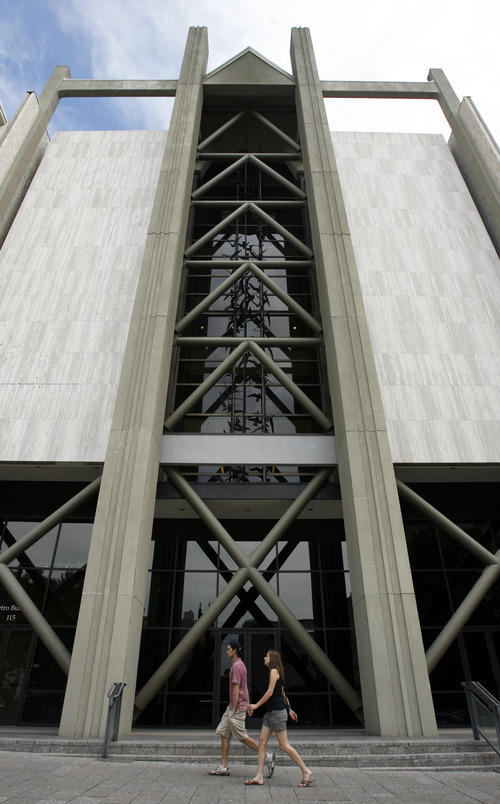This is an archived article that was published on sltrib.com in 2012, and information in the article may be outdated. It is provided only for personal research purposes and may not be reprinted.
It debuted to great hoopla in 1963, when many in Salt Lake City saw it as a symbol of a new and exciting time downtown. But times change. Soon it could come crashing down, bowing out to make way for a Broadway-style theater.
The Prudential Building at 115 S. Main was the brainchild of iconic American architect William L. Pereira, known for his skyline-piercing Transamerica pyramid in San Francisco.
According to news reports of the time, Salt Lakers were practically giddy that such a famous architect would grace Main Street with his bold and beautiful touch.
The structure boasted a sunken garden, reflecting pool and a huge interior atrium with skylights. Outside, 100 life-size bronze sea gulls soared up the front façade
Today, the Prudential Building is just shy of 50 years old and is seen as an exceptional example of the architecture of its time.
But if Salt Lake City's plans move forward, it will be reduced to dust and twisted steel, along with several other buildings, for the Utah Performing Arts Center — a 2,500-seat theater championed by Mayor Ralph Becker and the Salt Lake City Redevelopment Agency.
Like the Prudential Building before it, the proposed $110 million mega-theater is being touted as key to a downtown renaissance.
Although the edifice was a big deal in the '60s, these days most Utahns and Salt Lakers are unaware of the Prudential Building on the east side of Main between 100 South and 200 South, said Kirk Huffaker, executive director of the Utah Heritage Foundation.
"Part of it is that buildings from the 1960s are not reminiscent of the Victorian era [or other easily recognizable styles]," he said. "It's one of those styles where there is a lack of understanding and appreciation."
Trumpeting of the proposed playhouse, apparently, provided little opportunity for public discussion of demolitions and the associated historical trade-offs.
"From our point of view," Huffaker said, "any time we talk about demolishing older buildings, the value for doing that needs to be viewed against what comes with it."
Stephen Goldsmith, Salt Lake City's former planning director, said razing the Prudential Building is made easy because "it doesn't exist in the mind's eye of the community."
That may be due to downtown's difficulties during the past several decades and the fact that many area residents grew up in the suburbs and are unaware of the city's architectural gems.
But Goldsmith's father, Larry, who was the proprietor of Arthur Frank clothiers across the street from the Prudential Building, recalled for his son the excitement the structure brought to town.
"It was a time when we were going to invest in quality and design excellence," Stephen Goldsmith said. "That was a building that was going to add significantly to the landscape of Main Street."
City Councilman Luke Garrott said he recalled little discussion about demolishing buildings on Main Street for the playhouse.
"Most people look at the Prudential and say, 'That's just an ugly building from the '60s with no historic value,' " Garrott said. "Nobody at City Hall has discussed it. … That disturbs me."
But Bob Farrington, the city's director of economic development, said the buildings that will be demolished for the theater did not lend themselves to be incorporated into the planned facility that has many technical demands.
After several years of study, the Main Street site was selected for proximity to other amenities, including the new multibillion-dollar City Creek Center, and the fact that it had been a dead zone of sorts.
"It was the hole in the doughnut in town for 20 years," he said.
Nonetheless, Farrington added, it's possible that some design elements of the Prudential could be incorporated into the mega-theater.
Think, perhaps, bronze sea gulls flying across the marquee.



